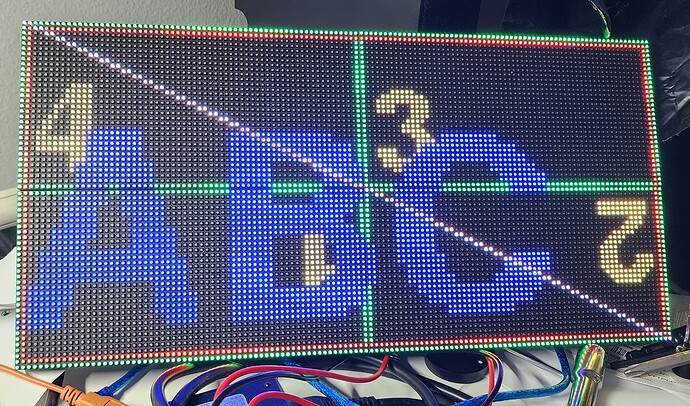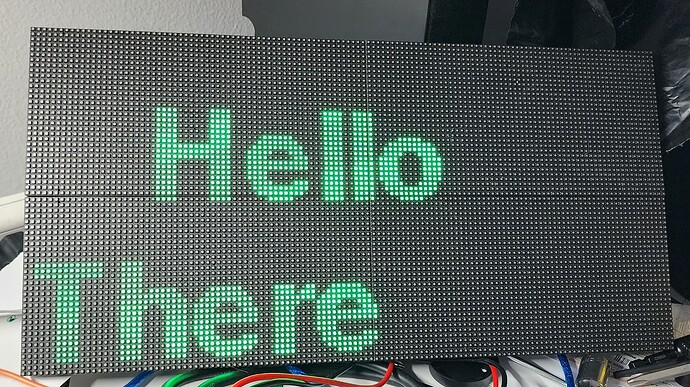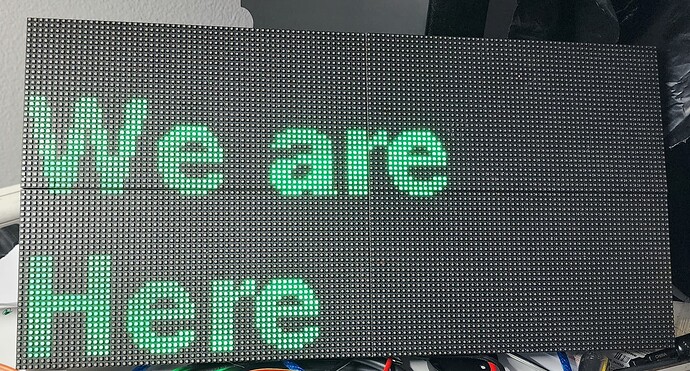I have tried to adapt this code for Serial.read() however very unsuccessfully,
Have 4 panels in the grid like shows in comments in middle of the code got the rest of the code to work properly, however when i tried to implement the serial read that worked for standard WS2812 Leds it does not like it and has a total fit and says every thing is wrong.
Since it is a vertiual matrix it makes it a little more complicated.
Still in the newbie stage so I know that somehow it was my implantation.
I am trying to get it to read from vixenlights to run the display.
I appreciate in help in advance. Just frustrating trying to find information on the internet when there is too much to process.
by the way this is a ESP32 which happens to run on the same code as arduino.
/******************************************************************************
-------------------------------------------------------------------------
Steps to create a virtual display made up of a chain of panels in a grid
-------------------------------------------------------------------------
Read the documentation!
https://github.com/mrfaptastic/ESP32-HUB75-MatrixPanel-DMA/tree/master/examples/ChainedPanels
tl/dr:
- Set values for NUM_ROWS, NUM_COLS, PANEL_RES_X, PANEL_RES_Y, PANEL_CHAIN_TYPE.
- Other than where the matrix is defined and matrix.begin in the setup, you
should now be using the virtual display for everything (drawing pixels, writing text etc).
You can do a find and replace of all calls if it's an existing sketch
(just make sure you don't replace the definition and the matrix.begin)
- If the sketch makes use of MATRIX_HEIGHT or MATRIX_WIDTH, these will need to be
replaced with the width and height of your virtual screen.
Either make new defines and use that, or you can use virtualDisp.width() or .height()
*****************************************************************************/
// 1) Include key virtual display library
#include <ESP32-VirtualMatrixPanel-I2S-DMA.h>
#include <FastLED.h>
// 2) Set configuration
#define PANEL_RES_X 64 // Number of pixels wide of each INDIVIDUAL panel module.
#define PANEL_RES_Y 32 // Number of pixels tall of each INDIVIDUAL panel module.
#define NUM_ROWS 2 // Number of rows of chained INDIVIDUAL PANELS
#define NUM_COLS 2 // Number of INDIVIDUAL PANELS per ROW
#define PANEL_CHAIN NUM_ROWS*NUM_COLS // total number of panels chained one to another
/* Configure the serpetine chaining approach. Options are:
CHAIN_TOP_LEFT_DOWN
CHAIN_TOP_RIGHT_DOWN
CHAIN_BOTTOM_LEFT_UP
CHAIN_BOTTOM_RIGHT_UP
The location (i.e. 'TOP_LEFT', 'BOTTOM_RIGHT') etc. refers to the starting point where
the ESP32 is located, and how the chain of panels will 'roll out' from there.
In this example we're using 'CHAIN_BOTTOM_LEFT_UP' which would look like this in the real world:
Chain of 4 x 64x32 panels with the ESP at the BOTTOM_LEFT:
+---------+---------+
| 4 | 3 |
| | |
+---------+---------+
| 1 | 2 |
| (ESP) | |
+---------+---------+
*/
#define VIRTUAL_MATRIX_CHAIN_TYPE CHAIN_BOTTOM_LEFT_UP
// 3) Create the runtime objects to use
// placeholder for the matrix object
MatrixPanel_I2S_DMA *dma_display = nullptr;
// placeholder for the virtual display object
VirtualMatrixPanel *virtualDisp = nullptr;
// placeholder for the matrix object
// MatrixPanel_I2S_DMA *dma_display = nullptr;
/********************************
It did not like this section
const uint16_t colors[] =
{
virtualDisp->Color(255, 0, 0), virtualDisp->Color(0, 255, 0), virtualDisp->Color(0, 0, 255)
};*/
uint16_t time_counter = 0, cycles = 0, fps = 0;
unsigned long fps_timer;
CRGB currentColor;
CRGBPalette16 palettes[] = {HeatColors_p, LavaColors_p, RainbowColors_p, RainbowStripeColors_p, CloudColors_p};
CRGBPalette16 currentPalette = palettes[0];
CRGB ColorFromCurrentPalette(uint8_t index = 0, uint8_t brightness = 255, TBlendType blendType = LINEARBLEND) {
return ColorFromPalette(currentPalette, index, brightness, blendType);
}
/******************************************************************************
* Setup!
******************************************************************************/
void setup() {
Serial.begin(115200);
/******************************************************************************
* Create physical DMA panel class AND virtual (chained) display class.
******************************************************************************/
/*
The configuration for MatrixPanel_I2S_DMA object is held in HUB75_I2S_CFG structure,
All options has it's predefined default values. So we can create a new structure and redefine only the options we need
Please refer to the '2_PatternPlasma.ino' example for detailed example of how to use the MatrixPanel_I2S_DMA configuration
*/
HUB75_I2S_CFG mxconfig(
PANEL_RES_X, // module width
PANEL_RES_Y, // module height
PANEL_CHAIN // chain length
);
//mxconfig.driver = HUB75_I2S_CFG::FM6126A; // in case that we use panels based on FM6126A chip, we can set it here before creating MatrixPanel_I2S_DMA object
virtualDisp->begin(); //initalize the matrix
virtualDisp->setTextWrap(false);
virtualDisp->setBrightness(40);
virtualDisp->setTextColor(colors[0]);
int x = 16; //holds the width of the matrix for counting colums
int pass = 0; //used to calculate the number of characters read from the serial input
// Sanity checks
if (NUM_ROWS <= 1) {
Serial.println(F("There is no reason to use the VirtualDisplay class for a single horizontal chain and row!"));
}
// OK, now we can create our matrix object
dma_display = new MatrixPanel_I2S_DMA(mxconfig);
// let's adjust default brightness to about 75%
dma_display->setBrightness8(192); // range is 0-255, 0 - 0%, 255 - 100%
// Allocate memory and start DMA display
if( not dma_display->begin() )
Serial.println("****** !KABOOM! I2S memory allocation failed ***********");
// create VirtualDisplay object based on our newly created dma_display object
virtualDisp = new VirtualMatrixPanel((*dma_display), NUM_ROWS, NUM_COLS, PANEL_RES_X, PANEL_RES_Y, VIRTUAL_MATRIX_CHAIN_TYPE);
// So far so good, so continue
virtualDisp->fillScreen(virtualDisp->color444(0, 0, 0));
virtualDisp->drawDisplayTest(); // draw text numbering on each screen to check connectivity
void loop ()
{
virtualDisp->fillScreen(0); //clear the screen
virtualDisp->setCursor(x, 0); //set the begining cursor position
serialtochar();
chartoscreen();
} //end loop
void serialtochar()
{
while (Serial.available()) //if serial data is available, run the loop
{
delay(10);
if (Serial.available() > 0) //if there is serial data continue
{
char c = Serial.read(); //read the next byte of data
readString += c; //append the data to the char variable readString
}
}
}
void chartoscreen()
{
if (readString.length() > 0) //if the number of bytes in readString are greater than 0
{
virtualDisp->println(readString); //print the data in readString
pass = -abs(readString.length()); //set pass to the negative value of the number of characters
if(--x < pass * 6) //reserve 6 spaces for each character - continue looping until x = pass * 6
{
x = virtualDisp->width(); //set x to the number of colums in the matrix
readString = ""; //set the data to blank
}
virtualDisp->show(); //show the data stored
delay(70); //wait a bit - sets scrolling speed
}
}}
/* This for testing
// delay(1000);
Serial.println("Chain of 4x 64x32 panels for this example:");
Serial.println("+---------+---------+");
Serial.println("| 4 | 3 |");
Serial.println("| | |");
Serial.println("+---------+---------+");
Serial.println("| 1 | 2 |");
Serial.println("| (ESP32) | |");
Serial.println("+---------+---------+");
// draw blue text
virtualDisp->setFont(&FreeSansBold12pt7b);
virtualDisp->setTextColor(virtualDisp->color565(0, 0, 255));
virtualDisp->setTextSize(2);
virtualDisp->setCursor(0, virtualDisp->height()- ((virtualDisp->height()-45)/2));
virtualDisp->print("ABCD");
// Red text inside red rect (2 pix in from edge)
virtualDisp->drawRect(1,1, virtualDisp->width()-2, virtualDisp->height()-2, virtualDisp->color565(255,0,0));
// White line from top left to bottom right
virtualDisp->drawLine(0,0, virtualDisp->width()-1, virtualDisp->height()-1, virtualDisp->color565(255,255,255));
// virtualDisp->drawDisplayTest(); // re draw text numbering on each screen to check connectivity
delay(2000);
virtualDisp->fillScreen(virtualDisp->color444(0, 0, 0));
delay(2000);
virtualDisp->setFont(&FreeSansBold12pt7b);
virtualDisp->setTextColor(virtualDisp->color565(0, 222, 0));
virtualDisp->setTextSize(1);
virtualDisp->setCursor(0, virtualDisp->height()- ((virtualDisp->height())/2));
virtualDisp->print(" Hello There");
delay(2000);
virtualDisp->fillScreen(virtualDisp->color444(0, 0, 0));
delay(500);
virtualDisp->setTextColor(virtualDisp->color565(0, 222, 0));
virtualDisp->setTextSize(1);
virtualDisp->setCursor(0, virtualDisp->height()- ((virtualDisp->height())/2));
virtualDisp->print("We are Here");
delay(2000);
virtualDisp->fillScreen(virtualDisp->color444(0, 0, 0));
delay(1000);
// Set current FastLED palette
currentPalette = RainbowColors_p;
Serial.println("Starting plasma effect...");
fps_timer = millis();
}
void loop() {
for (int x = 0; x < virtualDisp->width(); x++) {
for (int y = 0; y < virtualDisp->height(); y++) {
int16_t v = 0;
uint8_t wibble = sin8(time_counter);
v += sin16(x * wibble * 3 + time_counter);
v += cos16(y * (128 - wibble) + time_counter);
v += sin16(y * x * cos8(-time_counter) / 8);
currentColor = ColorFromPalette(currentPalette, (v >> 8) + 127); //, brightness, currentBlendType);
dma_display->drawPixelRGB888(x, y, currentColor.r, currentColor.g, currentColor.b);
}
}
++time_counter;
++cycles;
++fps;
if (cycles >= 1024) {
time_counter = 0;
cycles = 0;
currentPalette = palettes[random(0,sizeof(palettes)/sizeof(palettes[0]))];
}
// print FPS rate every 5 seconds
// Note: this is NOT a matrix refresh rate, it's the number of data frames being drawn to the DMA buffer per second
if (fps_timer + 5000 < millis()){
Serial.printf_P(PSTR("Effect fps: %d\n"), fps/5);
fps_timer = millis();
fps = 0;
}
*/
}//END LOOP
/*****************************************************************************
Thanks to:
* Brian Lough for the original example as raised in this issue:
https://github.com/mrfaptastic/ESP32-HUB75-MatrixPanel-I2S-DMA/issues/26
YouTube: https://www.youtube.com/brianlough
Tindie: https://www.tindie.com/stores/brianlough/
Twitter: https://twitter.com/witnessmenow
* Galaxy-Man for the kind donation of panels make/test that this is possible:
https://github.com/Galaxy-Man
`*****************************************************************************/
however the plasma display is only on half, no biggie not going for that.



